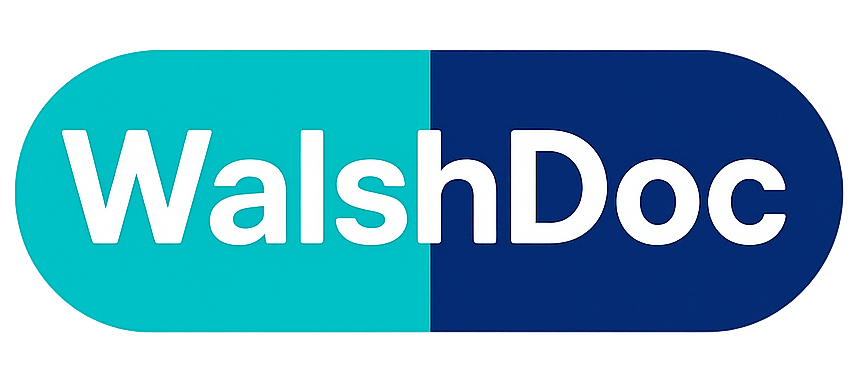Walsh Biotypes: Understanding the Biochemical Patterns Behind Mood & Behavior
The Walsh Protocol identifies five core biochemical biotypes that strongly influence mood, behavior, stress tolerance, cognition, and emotional regulation.
These patterns were originally established by William J. Walsh, PhD through analysis of more than 30,000 patient datasets, and later expanded clinically by practitioners using functional labs and nutrient therapy.
Biotypes explain, for instance, why two individuals with “anxiety” or “depression” respond differently — because their underlying chemistry is different.
WalshDoc helps clarify these biochemical patterns using symptoms, history, and optional lab testing.
Why Biotypes Matter
Each biotype reflects a predictable combination of:
-
nutrient imbalances (zinc, copper, B6, SAMe, folate)
-
oxidative stress
-
inflammation
-
neurotransmitter activity
-
detox or metabolic stress
These factors shape a person’s stress response, sleep, motivation, attention, emotional reactivity, and treatment response.
Correct identification allows targeted nutrient therapy instead of guesswork.
The 5 Walsh Biotypes
Below is a simple overview of each biotype. You’ll find links to full pages with symptoms, biochemical markers, and therapeutic considerations.
1. Undermethylation (High Histamine Type)
Undermethylation is the most common biotype associated with:
-
inner tension, irritability, OCD tendencies
-
perfectionism, competitiveness
-
high achievers with internalized stress
-
seasonal allergies or low serotonin production
Biochemical markers often include:
-
high whole-blood histamine
-
low SAMe / high SAH
-
low serotonin and dopamine activity
-
elevated basophils
This biotype typically responds well to methylation support, creatine, and targeted amino acid strategies.
[Learn more → Undermethylation]
2. Pyroluria (Kryptopyrrole Disorder)
Pyroluria involves excessive kryptopyrroles binding to zinc and vitamin B6, leading to:
-
anxiety, social withdrawal
-
mood swings, low stress tolerance
-
light sensitivity, poor dream recall
-
eczema, stretch marks, poor wound healing, hypermobile joints
Biochemical markers include:
-
elevated urine kryptopyrroles
-
low plasma zinc
-
low B6 or high need for P5P
This biotype benefits from zinc, P5P, antioxidants, and gradual stabilization before adding methylation support if needed.
[Learn more → Pyroluria]
3. Copper Overload
Copper overload affects dopamine and norepinephrine pathways, contributing to:
-
anxiety, panic, or overstimulation
-
ADHD-like symptoms
-
emotional lability
-
estrogen dominance or postpartum symptoms
Lab markers often include:
-
high copper
-
low zinc
-
high copper:zinc ratio
-
low ceruloplasmin
Treatment focuses on balancing copper and zinc, supporting detox pathways, and reducing oxidative stress.
[Learn more → Copper Overload]
4. Overmethylation (Low Histamine Type)
Overmethylation is less common but often presents with:
-
high sensitivity
-
ADHD, insomnia, anxiety with sensory overload
-
creative or imaginative thinking
-
adverse reactions to methyl donors
Biochemical indicators:
-
very low whole-blood histamine
-
high methylation activity
-
high serotonin and dopamine activity
- low folate, high homocysteine, macrocytosis
Treatment usually avoids methyl donors and focuses on folates, niacin, histamine-supportive, and nervous system calming nutrients.
[Learn more → Overmethylation]
5. Toxic Overload / Oxidative Stress Dominance
This pattern reflects environmental or metabolic stressors that overwhelm detox pathways:
-
chronic fatigue
-
chemical sensitivity
-
brain fog
-
slow recovery after stress or illness
Lab indicators may include:
-
high oxidative stress markers
-
poor liver detoxification, low glutathione
-
dysbiosis, kidney impairment or SAH accumulation
-
impaired mitochondrial function (organic acids)
Therapy focuses on glutathione support, antioxidants, detoxification pathways, mitochondrial repair, diet modification, medication adjustments and inflammation reduction.
[Learn more → Toxic Overload]
How Biotyping Works at WalshDoc
WalshDoc offers a clear, structured approach:
Step 1 — Quick Screen (Free)
A short questionnaire identifies which biotypes are likely involved.
Step 2 — Full Questionnaire
A deeper intake refines pattern recognition and generates a personalized summary.
Step 3 — Lab Testing Options
You may confirm patterns with:
-
whole-blood histamine
-
copper / zinc / ceruloplasmin
-
urine pyrroles
-
methylation markers
-
organic acids
Step 4 — Physician-Guided Plan
Your biotype is translated into a practical nutrient program with monitoring and adjustments.
Start Learning Your Biotype
Find the biotype that matches your symptoms and learn what therapies can help you feel and function better.
